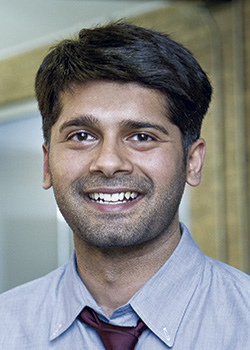A longtime player in the 3-D rendering space, Sonny + Ash (formerly Studio Rendering), a Chicago-area visual communications firm, is headed toward making virtual reality (VR) a standard service provided to its clients — designers, as well as large hotel and restaurant companies — as a visualization tool.
 Ash Mohammed, Chief Creative Officer, Sonny + Ash, http://www.sonnyash.com/Ash Mohammed, an architect who also holds a degree in construction project management, joined founder Sonny Sultani in the business 10 years ago. He says the simplicity and accessibility of VR, and the speed with which it can now be brought into the design review process, make it an easy and affordable way for operators to experience the most realistic representation of their spaces possible, down to lighting levels morning, noon and night and specific sight lines from every seat in the house.
Ash Mohammed, Chief Creative Officer, Sonny + Ash, http://www.sonnyash.com/Ash Mohammed, an architect who also holds a degree in construction project management, joined founder Sonny Sultani in the business 10 years ago. He says the simplicity and accessibility of VR, and the speed with which it can now be brought into the design review process, make it an easy and affordable way for operators to experience the most realistic representation of their spaces possible, down to lighting levels morning, noon and night and specific sight lines from every seat in the house.
Why the excitement about virtual reality right now when the technology has been available for quite a while?
AM: Right, it’s not like the 360-degree view wasn’t available before. What makes it different now is the accessibility of the technology. Before, while we had virtual reality capabilities, most people didn’t have cell phones that could handle that kind of movement. Now, we have technology that fits within our hands, and through that very familiar, accessible technology, we can use VR to provide a much more immersive way to experience design. Previously, we could download a QuickTime VR model onto a computer, but now you don’t even have to do that. Everything is accessible right on your phone or iPad. It’s mobile, fast and almost universally accessible.
So no clunky computers and goofy goggles required?
AM: Well, that depends. There are different technologies, and it’s up to how the designer or client wants to experience VR. The simplest option, which you can view on your phone or iPad, is called monoscopic VR, in which you’re getting the 360-degree virtual view but from a single, flat field of vision. If you’re wearing goggles, you can experience stereoscopic VR. With that, you’re able to take the same 360-degree view and add depth. What your left eye sees is different from what your right eye sees, as is the case when you’re actually in a space. With Google establishing itself with the Google Cardboard VR viewer, simulations are much more realistic. If clients don’t have viewers, we can just send a few over, and all they need then is their phone or iPad. The most sophisticated VR systems, at the gaming level, are fantastic and even more realistic, but they’re not practical for most projects.
What are the big benefits of going to the next step, from 3-D renderings to VR?
AM: One is the fact that you can now get a VR model in less time than it typically takes to produce more traditional renderings. It’s also much more realistic, enabling operators and designers to spot potential problems or make changes earlier in the process. And it’s so simple to communicate. You’re not dealing with printing the entire content of a project and worrying about how this or that is going to look. You just have a backlit screen, an iPad in hand, and everyone can literally just spin around in their chairs to experience different parts of the space. When you’re looking at a rendering, you’re still getting a good experience, but you’re not really getting the full essence. With VR, you can get the full room view from every angle as well as the view from a specific table to check sight lines, etc. Comments from operators back to designers can be much more targeted, and projects get finished much quicker.



